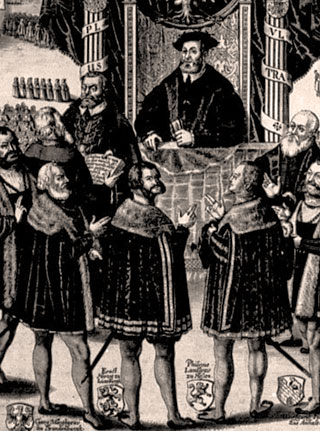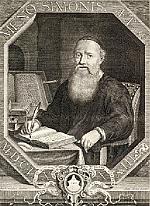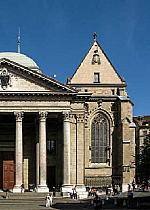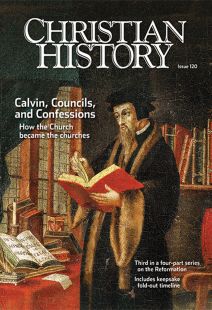From Luther to the Lutherans

[Lutherans present the Augsburg Confession to Emperor Charles V]
IN 1717 a Wittenberg homeowner had a carved stone in the wall of his house restored for the 200th anniversary of the Reformation. It read, “God’s Word and Luther’s writings are poison to the pope and Calvin.” It is ironic that two centuries after the Reformation began, Luther’s followers would be lumping Calvinism with Catholicism as his two greatest enemies. For in 1546, as Luther lay on his deathbed, both he and his allies were primarily concerned with Roman Catholic opposition.
After Luther’s death the movement he began came increasingly under attack from external threats and internal division that nearly spelled the end of it completely. It would take almost 30 years for it to recapture its vitality and cohesion. Meanwhile the followers of Calvin grew into an international Protestant movement, overshadowing Luther’s. Why?
Who’s next?
When Luther was laid to rest in the Castle Church of Wittenberg in the winter of 1546, there was no clear successor to step into his place. He was, as the men who eulogized him noted, a colossus, a modern-day Elijah, the successor to Old Testament prophets, and the fulfillment of a fateful prophecy given by Jan Hus at his martyrdom that someone would rise up a century later to vanquish papal idolatry. Not an easy act to follow.
Philip Melanchthon was Luther’s most gifted theological ally and a skilled teacher whose students were often devoted to him, but not the kind of man to lead movements. Almost 20 years before Luther’s death, when called upon to quickly write what has come to be called the Augsburg Confession, he had been equal to the task. Then, too, Luther’s movement had been in peril, and he had answered the call with grace and brilliance. But time would prove him an unlikely successor.
When Emperor Charles V attacked pro-Lutheran principalities in the Holy Roman Empire in the late 1540s, Melanchthon attempted to steer Luther’s movement through the violent storm. As the emperor pledged to wipe Luther and his followers from the map and from history, Melanchthon defended the Lutheran cause again. After all, he thought, the emperor was limited in power and scope.
But all soon changed in the months following Luther’s death. First Charles V placed an imperial ban on Lutheran prince John Frederick, using a squabble between him and another imperial noble as a pretext. He also placed a ban on the other great Protestant prince, Philipp of Hesse, but this ban called for the death penalty; Philipp had been caught red-handed in a bigamous marriage (which he had entered into with the consent of both Luther and Melanchthon), and the penalty for bigamy was death. Thus the two greatest Protestant princes were in grave danger, and their Lutheran subjects shared their fate.
Then Charles V managed to bribe one of the other Protestant princes—Maurice of Saxony—to flip sides. Maurice came to the emperor’s side not for religious reasons but for dynastic ones. His cousin, John Frederick, held an influential, monetarily significant, and very prestigious imperial office that Maurice’s side of the family had coveted for more than a century. Charles promised it to him if he helped attack his cousin’s lands.
Order Christian History #120: Calvin, Councils, and Confessions in print.
Subscribe now to get future print issues in your mailbox (donation requested but not required).
And so, in April 1547, Charles and Maurice attacked. John Frederick and Philipp of Hesse were caught off-guard by Maurice’s turn of allegiance, and their lines quickly collapsed. It was a rout, and John Frederick and Philipp were soon in the emperor’s hands.
No, really, we still believe all of it
Within months Charles V called an imperial diet to finally put an end to what he had long called the “Luther Affair.” Luther was dead and all his political allies were either defeated, in prison, or in hiding. Those who could attend the diet (or parliament) in 1548 found themselves in a city surrounded by the emperor’s army. It was nicknamed the “Armed Diet.” The emperor demanded almost the complete abandonment of all of Luther’s reforms.
Melanchthon and some of those still in Wittenberg tried to find a way to appease the emperor and still maintain the essential kernels of Luther’s theology. Melanchthon argued that what the emperor demanded amounted to nothing more than outward changes—like the return to priestly vestments instead of the black academic gown, which Protestants had adopted for presiding at worship and is often called today a “pulpit robe.”
This compromise made sense on some of the disputed issues, but others seemed to gut Luther’s theology at its core. The emperor’s demands required that churches reaffirm transubstantiation and rejected the doctrine of justification by faith alone.
Melanchthon continued to seek ways to appease the emperor and still save Luther’s cause, but others were less willing to compromise. Some refused outright and were imprisoned. Others fled, like Martin Bucer, who left Strasbourg and went to Cambridge to teach.
Some of Melanchthon’s students realized he was working to maintain Luther’s theological commitments and to defend his legacy. Others saw him as a sellout. Luther’s allies soon divided into two main camps—Philippists (supporters of Melanchthon) and so-called Gnesio-Lutherans, or True-Lutherans. A pamphlet war between the two sides erupted denouncing each other for betraying Luther.
The Gnesio-Lutherans also pointed their pens at the emperor, denouncing him for good measure and arguing that he ought to be resisted by force. Opposition began to center over time on a single city that steadfastly resisted the emperor’s demands and Maurice’s armies: Magdeburg.
The city of Magdeburg, downstream from Wittenberg, was one of the largest cities in northern Germany. It had large fortified walls and was protected by muddy fens and heath on the approach, with its back walls facing the river. The land around the city made it hard to bring siege works or the new weapon of the age—cannons—close enough to the city for a successful siege.
The river also supplied the city with necessary provisions and a way to distribute printed pamphlets across the empire. The most important pamphlet to be snuck out on a small boat was the Magdeburg Confession (1550), a reiteration of Luther’s core beliefs and a theological defense of the right of cities and princes to resist the emperor.
The city became a rallying point for opposition to both the emperor and Melanchthon. What happened there was watched with intense interest as far away as Geneva and London. After a fruitless siege, Duke Maurice—now awarded his cousin’s former title and much of his land—entered into an agreement with the city. Magdeburg could maintain the essentials of Luther’s theology in exchange for surrendering to Maurice on behalf of the emperor.
Family feud
Maurice had gained all that he had hoped for in betraying his cousin—who was also, incidentally, his father-in-law. Maurice’s wife, Agnes, whom he married without either set of parents’ permission and with whom he remained deeply in love, was Philipp of Hesse’s first-born child by Philipp’s discarded first wife. Angered by her father’s bigamy, Agnes agreed to Maurice’s plans to attack him and John Frederick. But neither Maurice nor Agnes had counted on the very harsh conditions under which the emperor held both princes. Nor had they counted on Philipp being condemned to death. (He was not executed; in fact, he was released in 1552.)
Before the emperor’s defeat of Philipp of Hesse and John Frederick, they had arguably been the two greatest lords in the empire, a check to the emperor’s power and ambition. With them out of the picture, the
unfettered emperor was now free to do more than bother Lutherans.
Maurice was also being treated as a traitor both in his own lands and in new lands he had gained by defeating John Frederick. And so, in January 1552, he flipped his allegiance again and signed a treaty with the French king to attack Charles V and his brother King Ferdinand.
Charles and Ferdinand were shocked by this sudden double-cross; Charles actually had to flee through an alpine pass to escape. But the imperial armies regrouped and killed Maurice in a counterattack. Despite this loss the Protestant side was still able to bring Charles V to the negotiating table, and in August 1552 the decrees implemented at the Armed Diet were suspended until the terms of a more permanent peace could be worked out.
“Whose reign—his religion”
That final peace between the Holy Roman Emperor and his Protestant princes was approved in 1555, at another diet held in Augsburg. The so-called Peace of Augsburg established that whoever ruled a particular imperial jurisdiction (or state) would determine its religious disposition. If you lived in Saxony and your lord was Lutheran, you were a Lutheran and Lutheranism was the official religion of the entire duchy. If you lived in a Roman Catholic region like Bavaria, you were Roman Catholic. The official designation of this was cuius regio, eius religio—”whose reign, his religion.”
This settled, at least until the early part of the seventeenth century, the battles between Roman Catholics and Lutherans in Germany. It also meant that the religious borders between Lutheran lands and Catholic lands hardened. Protestant evangelism in Catholic lands largely came to an end.
The unforeseen consequence of this was that Lutheranism did not really grow after the Peace of Augsburg. An occasional duke or count converted (one, Gebhard Truchsess von Waldburg of Cologne, even converted to Calvinism—which created another set of issues), but for the most part, the religious frontiers in the empire were settled.
While nobles and princes had fought two wars and negotiated a political peace, the theological rift between those who had sided with Philip Melanchthon and those who had opposed him remained. In some respects, the establishment of a political peace made the theological divisions more apparent. What did it mean to be Lutheran? That was the question.
No deals with the devil
No theologian or pastor sets out to be a heretic or proclaim false doctrine. Arians and orthodox believers who fought at the Council of Nicaea were both trying to be as faithful to scriptural testimony about Jesus as they could. Heresy is the child of sincerity, passion, and stubbornness. The same might be said for the fights over the legacy of Martin Luther.
The opening clash was the contest to preserve the very legacy of Luther’s work and the protection of any future the movement might have. Melanchthon, as we have noted, believed that preserving Luther’s legacy meant accommodating the dictates of the Armed Diet and the victorious emperor.
He feared that if he did not find some compromise, all Luther’s work would simply be swept into the dustbin of church history, a footnote in a long line of heretics. He might have asked “When was the last time you saw an Albigensian church on a corner?” There are none, because they were defeated and hunted, and their doctrines were wiped away. He feared the same might happen to Luther.
Those who opposed Melanchthon believed that his compromises had already destroyed all that Luther had worked for. When did Luther compromise when the Gospel was at stake? Was not Melanchthon, they argued, calling for compromise with the same emperor whom Luther had stood before and uttered, “Here I stand, I can do no other, so help me God”? One does not make deals with the devil.
This clash, however, was a mere prelude. Within just a few years, an old debate that dated back to the early years of the Reformation reignited. What role do good works play in salvation? Luther tried to steer clear of antinomianism, the doctrine that performing works after salvation does not matter. Melanchthon had even written at one point that such works are essential. Luther made him back away from such language, but after the Armed Diet, Melanchthon revived it.
Others responded by claiming that good works are completely useless. Condemnations and recriminations flew back and forth. One prominent theologian was forced to publicly recant his position. While attempting to defend Luther or his theology, other pastors and theologians found themselves saying things they probably regretted later; but most were too stubborn or angry to retract.
In a debate over good works and salvation, for example, one defender uttered in anger that original sin became, in the Fall, humanity’s essential nature: the Fall did not just corrupt human nature or foul it, but completely changed its very core. That was a position outside of Christian orthodoxy.
Another author claimed that humanity plays no part in salvation. On one level, that was entirely consistent with Luther’s understanding of forensic justification: something that is declared by God, not earned by a person. Luther argued that we do good works not to earn salvation, but because we are saved.
However, in a debate, a former colleague of Luther’s ended up saying that only the divine nature of Christ plays a role in salvation: despite what centuries of orthodox theology stated, Christ’s becoming human has nothing to do with it. People in the room gasped. In a letter later, Melanchthon chided the author: what of the suffering of Christ on the cross?
Delivered from theology at last
Melanchthon died in April 1560. Always a bit melodramatic, he had expected his death a number of times before, but this time seemed different. In the days prior, still conscious that fear of death might be used to undermine his and Luther’s legacy, he wrote a short testament to his faith. At the end he thanked God that death would at last deliver him from the “madness of theologians.”
By the late 1560s, many of the other partisans of these debates were either dead, mellowed, or marginalized. A new generation of Lutheran princes had also risen to leadership, less dedicated to the fights of the past than their fathers and more interested in unifying their lands and their churches. The Formula of Concord began to take shape in the 1570s. It was an attempt to state unequivocally the essentials of Lutheran orthodoxy. The product of slow, meticulous work, it made declarations about all of the theological topics that had been so vigorously debated, but now with an air of compromise, an attempt to see a larger picture rather than fight about the tiny spaces at the margins of doctrines.
After the Formula was agreed to, it was collected with a set of creeds and statements of faith into the Book of Concord. The Book of Concord opens with three ecumenical creeds—the Apostles’ Creed, the Nicene Creed, and the Athanasian Creed—and also contains the Augsburg Confession, Luther’s Short and Long Catechisms, and a number of other foundational Lutheran treatises. It was printed in German in 1580, the fiftieth anniversary of the Augsburg Confession. A Latin edition was printed four years later. Both pastors and synods, and princes and lords approved and adopted it. This gave it tremendous authority. It remains in effect for most Lutheran churches to this day.
Even so Lutheranism did not grow. At least not much beyond Germany and Scandinavia, until Lutherans began to immigrate to the American colonies and South America. Henry Melchior Muhlenberg is often considered the first official Lutheran pastor in North America, arriving in 1742. There Lutheranism would put down new roots and find new life. But that is another story. CH
This article is from Christian History magazine #120 Calvin, Councils, and Confessions. Read it in context here!
Christian History’s 2015–2017 four-part Reformation series is available as a four-pack. This set includes issue #115 Luther Leads the Way; issue #118 The People’s Reformation; issue #120 Calvin, Councils, and Confessions; and issue#122 The Catholic Reformation. Get your set today. These also make good gifts.
By David M. Whitford
[Christian History originally published this article in Christian History Issue #120 in 2016]
David M. Whitford is professor of Reformation studies at Baylor University and author of A Reformation Life: The European Reformation through the Eyes of Philipp of Hesse.Next articles
From turmoil to peace
How Menno Simons and Pilgram Marpeck guided Anabaptists through troubled times
Mary S. SprungerAnother accidental revolutionary
The rise of the Reformed tradition in France—and its most famous son
Jon BalserakCalvin, Councils, Confessions, Did you know?
Calvin the teacher, Menno the preacher, Elizabeth the queen, and those unpronounceable French Protestants
the editorsSupport us
Christian History Institute (CHI) is a non-profit Pennsylvania corporation founded in 1982. Your donations support the continuation of this ministry
Donate








